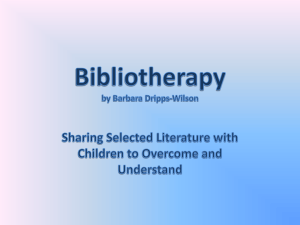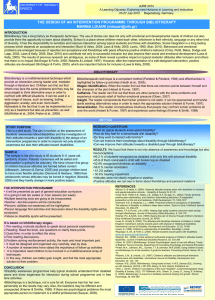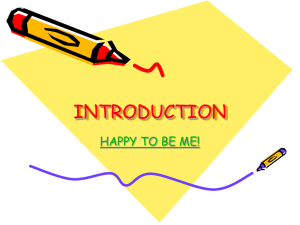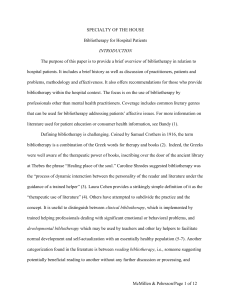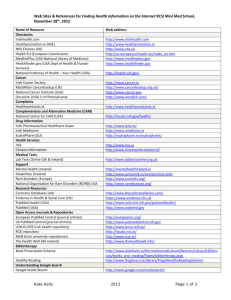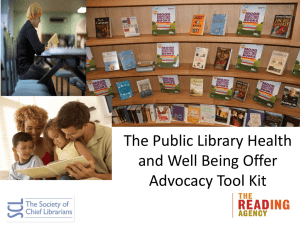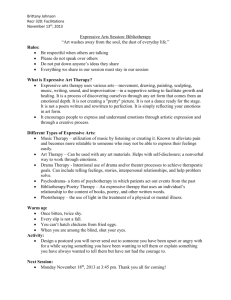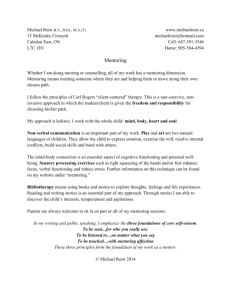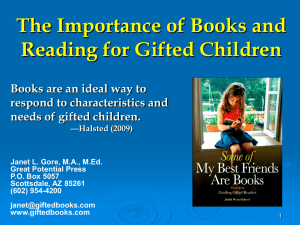12cc_049-066 - Adventist International Institute of Advanced
advertisement
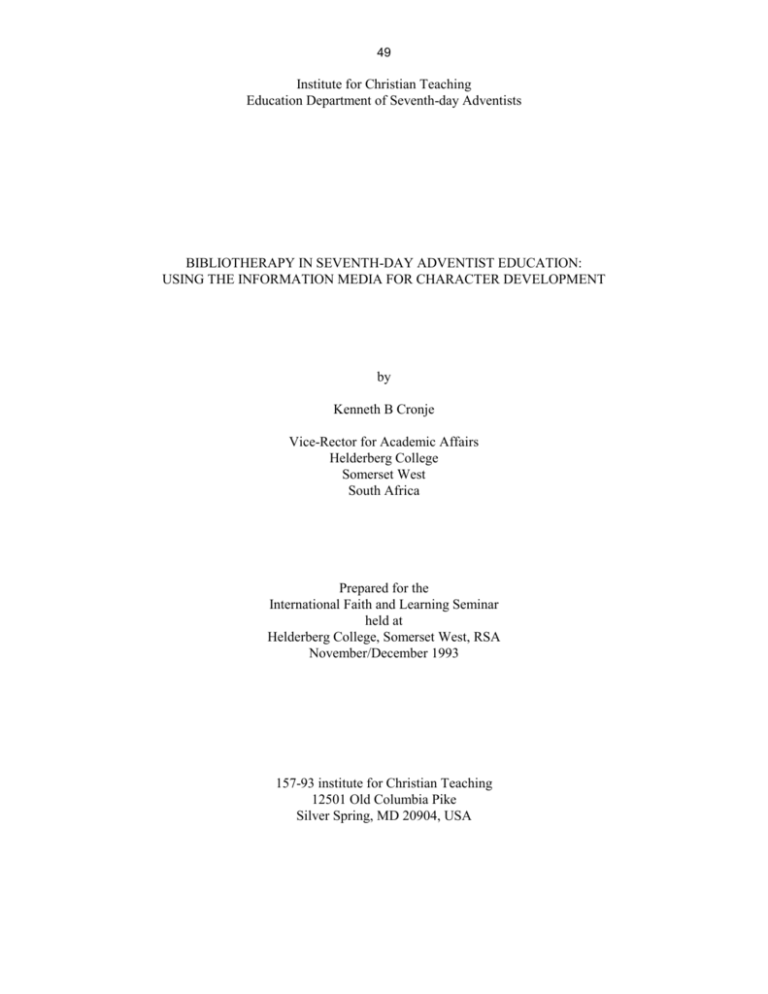
49 Institute for Christian Teaching Education Department of Seventh-day Adventists BIBLIOTHERAPY IN SEVENTH-DAY ADVENTIST EDUCATION: USING THE INFORMATION MEDIA FOR CHARACTER DEVELOPMENT by Kenneth B Cronje Vice-Rector for Academic Affairs Helderberg College Somerset West South Africa Prepared for the International Faith and Learning Seminar held at Helderberg College, Somerset West, RSA November/December 1993 157-93 institute for Christian Teaching 12501 Old Columbia Pike Silver Spring, MD 20904, USA 50 1. INTRODUCTION Bibliotherapy is considered by some to be a science requiring expert medical opinion, by others that it must be a team effort, and by still others as "an art to be practiced by a single individual who has an understanding of people, a wide knowledge of books, and is sympathetic to human needs" (Stoneburg in Swart: 1984: 35). Be that as it may, the art of bibliotherapy requires the same expertise as the science and this is demonstrated by non-medical professionals such as librarians, guidance counselors and teachers many of whom are in fact practicing bibliotherapy without being aware that they are using this technique (Haldeman & Idstein: 1979). The purpose of this paper is to indicate that when bibliotherapy is applied, it can be of benefit to students in our educational institutions in giving them insight into their problems, resulting in a change of behavior. Before we proceed any further, let us define bibliotherapy. 2. DEFINITIONS OF BIBLIOTHERAPY Different facets of bibliotherapy are highlighted in the following definitions: 2.1 "... the employment of books and the reading of them in the treatment of nervous disease" (Dorland's Illustrated Medical Dictionary: 1941, in Swart: 36). 2.2 "... a process of interaction between the personality of the reader and imaginative literature which may engage his emotions and free them for conscious and productive uses" (Schrodes: 1978, in Swart: 36). 2.3 "... a programme of selected activity involving reading materials, planned, conducted, and controlled as treatment ... for emotional and other problems" (Library Trends: 1962, in Swart: 36). 2.4 "... an activity programme based on the assimilation of the psychological, sociological and aesthetic values of imaginative and didactic information media in the human personality and behavior" (Cilliers: 1980: 8). "... a family of techniques for structuring an interaction between a facilitator and a participant ... based on their mutual sharing of literature" (Berry in Coleman and Ganong: 1988: 17). "... a program of activity on the interactive processes of media and the people who experience it. Print or nonprint material, either imaginative or informational is experienced and discussed with the aid of a facilitator" (Rubin: 1978: 2). 2.5 2.6 2.7 ".. getting the right book to the right child at the right time about the right problem" (Lundsteen in Cornett & Cornett: 1980: 9). All these definitions involve the use of information media to solve an individual's personal or emotional problems, i e, healing by means of information media. 3. HISTORICAL OVERVIEW The practice of bibliotherapy has existed and has been known since ancient times. At Thebes, the library bore the inscription, "The Healing Place of the Soul", while at St Gall in Switzerland, the Mediaeval Abbey Library had a similar inscription: "The Medicine Chest for the Soul." These inscriptions reflect an age-old belief in the therapeutic nature of literature. Various incidents and actions from the 19th and 20th centuries link this with our time: 51 3.1 In 1840 John Gait 11 of Williamsburg, Virginia, USA, published a book on the therapeutic nature of library service, which prompted a survey of American asylums. This led to his drawing up guidelines governing patients' reading and book selection. 3.2 In the 20th century, trained librarians began to administer hospital libraries. 3.3 The American Library Association (ALA) sponsored programmes for the Armed Forces in WorldWar I. 3.4 In 1916, Samuel Crothers used the word "bibliotherapy" for the first time. 3.5 On March 3, 1931, the American Congress passed legislation bringing library services to the blind through Braille books. 3.6 After World War II, bibliotherapy moved into educational and psychosocial areas. 3.7 In 1949, Carline Schrodes discussed in her doctoral dissertation the use of bibliotherapy as a treatment method of psycho-therapy. 3.8 In 1962, Ruth Tews wrote an article for Library Trends regarding bibliotherapy. 3.9 ALA had the following professional representation at its annual conference in 1964 where an entire workshop was devoted to bibliotherapy, psychiatry, clinical psychology, psychiatric nursing, social work, occupational therapy and of course libraries. 3.10 In June 1966 Congress passed the Library Service and Construction Act for the improvement of both state institutional library services and services offered to the physically handicapped. 3.11 An information explosion has provided us with many forms of information media, i e, printed and audio-visual materials which are used by counsellors and therapists as tools for helping clients gain perspectives on their problems and goals. 3.12 Bibliotherapy has filtered into areas other than librarianship and the medical field, e g, educational institutions. The brief review of the history of bibliotherapy demonstrates its continuing vitality. It can be concluded that although the ancients were aware of the therapeutic effects of reading, the practice of bibliotherapy is a relatively now science. In order to understand better the evolution of bibliotherapy into its present form, i e, that of directed reading and group discussion, one must trace the roots of bibliotherapy in both library science and psychology. 4. ROOTS OF BIBLIOTHERAPY 4.1 In Psychology Group therapy was advocated in the 1920's by Burrow and Adler (Rubin: 1978), but it was in the World War II era of 1939-1945 in which group therapy flourished. The number of wounded soldiers needing therapy was overwhelming and there were too many patients and not enough medical staff. 52 4.2 In Library Science Margaret Monroe (in Rubin: 1978) views bibliotherapy as part of the continuum of library services. Reference services, reading guidance and bibliotherapy are closely related functions, i e, all serve informational, instructional and guidance needs. Unlike reference services and reading guidance, bibliotherapy is a long-term approach to library services used for therapeutic purposes. Librarians were also serving patients in hospitals and veterans on the streets. The following diagram summarizes the roots of group bibliotherapy (Rubin: 1978: 18): ROOTS OF GROUP BIBLIOTHERAPY 5. BIBLIOTHERAPY AND THE INTEGRATION OF FAITH AND LEARNING The question may be posed as to what bibliotherapy has to do with the integration of faith and learning, and this will now be considered. 5.1 Once we accept that all truth is God's truth, we are committed to do something, i e, not only words but also deeds. Integration of faith and learning can take place on an individual level, i e, the teacher (Gaebelein: 1968). Ellen White also stresses the personal element in education: "Christ in His teaching dealt with men individually.... The same personal interest, the same attention to individual development, are needed in educational work today" (1952: 231/2). In this process, the teacher is the facilitator: "The educator's task is to inspire and equip individuals to think and act for themselves in the dignity of persons created in God's image" (Holmes: 1975: 16). One of the ways in which this may be done is through discussion of books specifically chosen for certain individuals in order to help them overcome emotional and behavior problems. Altmann and Nielsen (in Marock,: 1983) claim that research substantiates this. 5.2 The purposes of educational bibliotherapy are diverse: to impart information; to provide insight; to stimulate discussions about problems; to communicate new attitudes and values; to teach new solutions to problems; to enhance self-esteem; to furnish relaxation and diversion (Coleman & Ganong: 1988). 53 5.3 In the educational situation, bibliotherapy can be of two types, viz, corrective and preventive. In the former, a teacher, counselor, or librarian attempts to solve an actual or perceived problem of the student by presenting a book depicting a similar situation. By reading the book the student gains insight, which may enable him to solve his own problem. In the latter, a student is requested to read a book containing a problem he may have to deal with in the future. In the reading of the book, he may be better able to adjust, should a similar situation arise in his own life (Stoneburg in Swart: 1984). 5.4 Literature abounds with information on reading as a therapy (Stoneburg, Hutcheson, ALA in Swart). In summing it up, reading: 6. 5.4.1 has a positive effect upon personality; 5.4.2 helps persons solve personal problems and concerns; 5.4.3 Expands potential for growth and development; 5.4.4 Provides instruction, knowledge, understanding and inspiration. COMPONENTS OF BIBLIOTHERAPY The following components will be discussed in turn: *Aim and related objectives *Different categories *Types of information media used *Dynamics of the aesthetic experience 6.1 The Aim and Related Objectives of Bibliotherapy Moses (in Marock: 1983) lists the following aims of bibliotherapy: 6.1.1 To give the person insights and solutions to his problems through identification with the characters in the books he reads; 6.1.2 To inform and to explain to him the complexities of human behavior; 6.1.3 To afford him the opportunity of liberation from stress. According to Cilliers (1980), the main aim of bibliotherapy is to give insight and discernment of problems so as to bring about a change in attitude and behavior. Attitude is the way one thinks and feels and then reacts, while behavior is not only conduct but what a person thinks he should do, i e, social norms, what they normally do, i e, habits, and the results of the behavior. 54 THE AIM OF BIBLIOTHERAPY Gaining of comprehension and insight Change in attitude and behavior Therapy Emotional/Social Education Intellectual Relaxation The three long-term objectives shown diagrammatically, viz, therapy, education and relaxation can be considered on three levels, i e, intellectual, social and emotional. In other words, the therapy objective relates to the social and emotional level, while the education objective to the intellectual level. The objective in the area of relaxation is to make available to the client as a source of compensation or reward information media to be utilized in his free time. 6.1.3.1 Therapy on the emotional level helps the client to understand his psychological and physical reactions to frustration and conflict and to gain a clearer understanding of his motives and needs. Help is obtained through different types of information media, e g, books and films, where he can read and see how others have handled problems similar to the ones he is facing. As Schlabassie (in Cilliers: 1980: 30) stated succinctly, it is "providing vicarious experience without immediately exposing oneself to the dangers of actual experience." The client is then encouraged to discuss his problem freely. 6.1.3.2 Therapy on the social level involves the evaluation of values through information media. Through constant contact with characters in the information media, he develops a social sensitivity and through observing their needs and aspirations, he makes application in his own life. The family and the church can provide assistance by helping him to absorb cultural patterns. 6.1.3.3 Education on the intellectual level concerns the stimulation of new creative interests, development of the idea that there is more than one solution to a problem, and encouragement of positive and constructive thinking. Through the information media, the client is faced with the problem he is experiencing and it is discussed objectively with a view to finding a possible solution (Cilliers: 1980). 6.2 Categories of Bibliotherapy Three categories of bibliotherapy may be distinguished, viz, institutional, clinical and developmental (Cilliers: 1980). 6.2.1 Institutional bibliotherapy uses didactic information media for individual institutionalized clients. It embraces the medical and psychiatric use of bibliotherapy, with a person-to-person situation through a bibliotherapist working with a medical team. 55 6.2.2 Clinical bibliotherapy uses imaginative information media for groups of clients with emotional and behavioural problems. The team is made up of a bibliotherapist and a clinical worker seeking the attainment of insight and change in conduct and behavior. 6.2.3 Developmental bibliotherapy uses imaginative or didactic information media or a combination of both with groups of normal individuals in the community. The bibliotherapy group is led by a bibliotherapist and an educator to foster normal development, selfrealization and mental health. A noticeable characteristic common to all categories is that a discussion must take place about what is read, seen or heard. 6.2.4 Summary of the Categories of Bibliotherapy (Rubin: 1978: 7) Institutional Clinical Development Format Individual or group; Usually passive Group-active; Voluntary or involuntary Group-active; Voluntary Client Medical or psychiatric Patient, prisoner, or client in Private practice Person with an emotional or behavioral problem "normal" person, often in a crisis situation Contractor Society Society or the individual Individual Therapist Physician & librarian team Physician, mental health worker, or librarian, often in consultation Librarian, teacher, or other Material used Traditionally didactic Imaginative literature Imaginative literature and/or didactic Technique Discussion of material Discussion of material, with emphasis on client's reactions and insights Discussion of material, with emphasis on client's reactions and insights Setting Institution or private practice Institution, private practice or community Community Goal Usually informational, with some insight Insight and/or behavior change Normal development and self-actualization 56 6.3 Information Media Appropriate for use in Bibliotherapy 6.3.1 Principles of selection of materials (Rubin: 1978): 6.3.1.1 Materials with which the therapist is familiar must be used, i e, literature suggested must have been read, videocassettes previewed. 6.3.1.2 When selecting materials, the therapist should be conscious of length short works are physically easier to read and recall. 6.3.1.3 Materials should be applicable to the problem but not necessarily identical to it. 6.3.1.4 Choice of materials should be influenced by the reading ability of the client. 6.3.1.5 Chronological and emotional age is an important factor and should be reflected in the sophistication of the selected material. 6.3.1.6 Reading preferences are also a guideline for selection, e g, children and adolescents go through different stages and reading preferences change. For example, during the early stages, interest is in animal and adventure stories, etc, and later the interest changes to stories of romance, war, and adolescent life. 6.3.1.7 The therapist should learn to know the client well so that materials expressing the feeling or mood of the client can be selected. 6.3.1.8 Cartoons and comics, which have been carefully considered, may also be used. 6.3.2 Media suitable for use in bibliotherapy include written and audio-visual materials, both subject and imaginative. 6.3.2.1 Subject literature can be divided into empirical, natural and social sciences, technology and humanities. The goal of this type of literature is to help the client to a better understanding of his environment and of reality. 6.3.2.2 Imaginative literature (belles-lettres) is made up of novels, drama, poetry, short stories and essays. This type of literature is concerned with the affective reactions, and imagination incorporating the will and intellect. This type of literature has a greater potential than subject literature to change an individual. It broadens the understanding of personal motivation and cultural conflicts. Schrodes (in Cilliers: 1980: 37/38) states that "psychiatrists and psychologists generally acknowledge that great artists are penetrating interpreters of the personality ... have intuitively plumbed the depths of the human psyche and emerged with incisive descriptions of the dynamics of the personality." 6.3.2.3 Audio-visual media are also used in bibliotherapy and here we also have subject and imaginative information. Forms are films, record players, tape recorders, videocassettes, radio and television programmes. At times this is the only form of information media that can be used for 57 certain client groups, e g, illiterates, those with low educational levels, and the bored. Audiovisual media are non-demanding and non-anxiety provoking. They can be used for large groups of clients and the reaction is instantaneous and intense but not long lasting. Films are more direct and immediate than books and elicit a high degree of recall. Music can also be used and as Juliett Alvin (in Cilliers: 1980: 30) says, "it works through the effects of sound on man who is a resonant body able to perceive and to emit sound. ... The influence of music on man's behavior has been used universally as a healing power by magic, religion and medicine." According to Klapper (in Cilliers: 1980: 38), the radio will reach people, which literature and films will fail to do. This audience tends to be more suggestible than the audience of other media. Clients can listen as a group. Television is another medium which Michael Novak (in Cilliers: 1980: 30/40) describes as "a moulder of the soul's geography. It builds up incrementally a psychic structure of expectation." Programmes can be discussed and this stimulates informative needs. However, only a limited number of personal emotions, situations and motives can be handled. No research has yet been carried out in comparing the therapeutic effects of literature and audio-visual media. Loevinger (in Cilliers: 1980: 40) postulates a reflective-projective theory of mass communication, which is closely related to the theory of bibliotherapy, viz, "while the mass media reflect various images of society, the audience is composed of individuals, each of whom views the media as an individual. The members of the audience project or see in the media their own visions or images in the same manner that an individual projects his own ideas into the inkblots of the Rorschach Test commonly used by psychologists." 6.3.3.4 Particularly in the context of the integration of faith and learning, God's "two books", Scripture and nature, provide a wide spectrum of subject and imaginative exposure, both verbal and non-verbal, and these yield many opportunities for bibliotherapy in all its aspects. "Nothing is so calculated to enlarge the mind and strengthen the intellect as the study of the Bible. No other study will so elevate the soul and give vigor to the faculties as the study of the living oracles" (White: 1977: 93). "There is no position in life, no phase of human experience, for which the teaching of the Bible is not an essential preparation" (White: 1958: 599). Bible stories and especially the poetry in the book of Psalms can be used. 6.4 Dynamics of the Aesthetic Experience As has been stated, didactic information media are instructive and informative, while imaginative information media stimulate the imagination. The latter [ends itself more to the accomplishment of an emotional experience where the emotional processes develop parallel with the primary phases of traditional psychoanalysis (Cilliers: 1980): identification, projection, introjection, catharsis, insight. 6.4.1 In identification the client identifies himself with the chief character under study. As a result, the formation of values and social attitudes occur. 58 6.4.2 Through projection, the problem is projected outside the personality; blame can be placed on someone else. 6.4.3 The opposite of projection is introjection and here mistakes are accepted and placed on oneself instead of on others, i e, we internalize and put into ourselves the superego whose still, small voice reminds us of the values of our parents and society. A common example here is the identification with heroes and heroines who are admired. 6.4.4 The concept "catharsis" originated with Aristotle who looked upon it as a cleansing and purging through the expression of feelings. One reacts to the symbolic experience in literature as if it is an actual experience. 6.4.5 Finally, insight and integration start the change of personality (Cilliers: 1980, and Lewin: 1981). Norman Holland (in Cilliers: 1980), a literary critic and psychoanalyst, lists the following principles of the literary experience: 6.4.6 6.4.6.1 Style seeks itself, i e, readers react positively to material that fits in with their wishes and needs; 6.4.6.2 Defenses must be matched, i e, readers are attracted to characters who have similar defense mechanisms as they do as well as emotional values; 6.4.6.3 Fantasy projects fantasy, i e, personal fantasy is projected onto the story; 6.4.6.4 Character transforms characteristically, i e, a work is understood when the reader translates it into his inner language, taking into consideration his education, character, needs, defense mechanisms and fantasy. These principles of Holland reflect the idea that reading is an active process where the reader creates for himself a now experience-world that fits in with his needs, motives, experience and personality. The processes identification, projection, catharsis and insight are closely related to the needs and motives of the reader. All personal needs are covered by the following: Material, spiritual and social security needs, self-actualization, relaxation and aesthetic needs. 6.4.7 Three forms of needs are identified: 6.4.7.1 Inactive needs - the most difficult to evaluate as they must first develop before they can be activated; 6.4.7.2 Unspoken needs - there is an awareness of these but they are not satisfied; they need to be stimulated and given direction 6.4.7.3 Outspoken needs - spoken about and can usually be satisfied (Cilliers: 1980). These needs must be identified in order for the practice of bibliotherapy to be successful. 59 6.4.8 For the purpose of this study, the following motives are important: 6.4.8.1 6.4.8.2 6.4.8.3 6.4.8.4 6.4.8.5 Cognitive motives, i e, adjustment, orientation and interpretation motives; Prestige motives, i e, need for self-respect; Escapist motive, i e, reading for relaxation to escape conflict and frustration; Aesthetic motive, i e, literature that appeals to the imagination; Religious motive. These reading motives can reconcile the person's basic cognitive and aesthetic needs and also the needs for recognition, self-actualization and relaxation. 7. THE PROCESS OF BIBLIOTHERAPY The bibliotherapeutic process is activated by a client with a problem brought to the attention of the bibliotherapist. The bibliotherapist with the co-operation of the client and a multidisciplinary team sets the process going. The clinical worker diagnoses the problem and prescribes the handling, while the bibliotherapist selects the subjects of imaginative media and makes these available to the client. The client is the active one in the process and reads looks or listens. After this the client discusses what he has read, seen or heard with the bibliotherapist and the group. The problem is analyzed and insight and understanding brought about. The ideal is then for the client to accept this insight and understanding which will change his attitude and behavior. 7.1 Personal Characteristics The bibliotherapist should have the following personal characteristics: empathy, warmth and honesty, sensitivity, emotional stability, fairness, humor, initiative, receptiveness for change, ability to communicate verbally and non-verbally, objectivity, healthy judgment, intuition, self-assurance, authority to get things done. He needs to understand people thoroughly, have a wide knowledge of books, and be sympathetic to human needs. This indicates a congruent, genuine and integrated person. He also needs the ability to suggest the right reading material tactfully and without being too obvious. Practicing bibliotherapy cannot be made to appear too simple, or it is possible to do more harm than good 7.2 Education of the Bibliotherapis Besides the above-mentioned characteristics, those practicing bibliotherapy felt that the following would be beneficial courses in addition to the subjects necessary for their undergraduate degrees or diplomas in selected disciplines, viz, librarianship-user studies and readership, psychology, literature and counseling (Rubin: 1978). 7.3 Methods Used For bibliotherapy to be effective it must begin early, at the first sign of an emerging problem. The following methods may be used in bibliotherapy: 7.3.1 Individual bibliotherapist and individual client meet to discuss information media; 7.3.2 Subject literature is read out aloud and then discussed: This is the oldest method; 60 7.3.3 7.3.4 7.3.5 7.3.6 The client reads literature in his free time, i e, prepares for the session; Photocopied imaginative literature is read out aloud combined with music. This method involves all and the reactions are spontaneous. A combination of therapeutic reading and writing; Look-and-listen to audio-visual media followed by discussion. No matter what method is used, a discussion must always take place. This cannot be overemphasized as a amount of reading or watching of audiovisual materials can substitute for the vital give-and-take exchange between therapist and client. "Unless such a relationship is somewhere in the background, whole libraries ... will be of no avail" (Alston in Rubin: 1978: 32). 8. MILIEUS OF BIBLIOTHERAPY Bibliotherapy can be considered in our environs, viz, medical, psychiatric, educational, and rehabilitative. As indicated previously (see section 3), bibliotherapy, especially in the USA, is moving into other fields, e g, education and librarianship. As the barriers between institutions and society are broken down, the special services of hospitals and institution libraries, including bibliotherapy, take on a universal meaning in librarianship. The work is pioneered in the institution and then has a broader application in public and school libraries (Cilliers: 1980). 8.1 Bibliotherapy is applied mostly in the general medical milieu, i e, hospitals. Patients have medical, psychological and social problems and here bibliotherapy can be practised. A wide variety of problems are treated in the hospital and this is an excellent environment in which to use bibliotherapy, as a therapeutic team is always available. The category of bibliotherapy used here is institutional and clinical. 8.2 Another milieu is the psychiatric and the type of client treated here is the neurotic, manic-depressive, paranoid psychosis, schizophrenic, those with brain damage, alcoholics, drug addicts, those with old age problems and those with venereal diseases. Categories used here are institutional and clinical. Despite the fact that many may not be able to express themselves clearly, bibliotherapy can still be used with books, newspaper articles, radio and television programmes, films, slides, music, followed by a discussion. "Bibliotherapy in the psychiatric field is utilized in conjunction with other treatment techniques such as psychodrama, hypnosis, and insulin shock treatment, among others. It is also utilized with various psychopathogenic syndromes such as neurosis, functional psychosis and a variety of personal problems" (in Cilliers: 1980: 56). 8.3 In the educational milieu, books can play an important part. An attractive school library or media center is a vital aid to bibliotherapy in this area. Educationists and bibliotherapists can work together. Clients are pupils, students, adolescents, and persons with problems in the community. Corrective and preventative bibliotherapy is useful here. Categories of use here are institutional, clinical and developmental. Books must be well chosen and carefully analyzed. Teacher and bibliotherapist can decide on what method to use. "Inasmuch as the building of a wholesome, self-confident, selfrespecting, effective, happy personality is one of the major goals of education, the teacher is seeking constantly to find ways of giving each child the particular guidance that he needs. One of the ways in which such guidance can be given is through suggestions for reading in which the child may receive mental and emotional therapy through identification with a character in a book who faced a problem or situation similar to the child's own problem or situation" (Cilliers: 1980: 57). 61 8.4 The rehabilitation milieu includes prisoners, alcoholics, drug addicts, and the mentally retarded. Bibliotherapy is seldom used here as it is still as yet underdeveloped in this milieu. In institutions, these persons are kept busy but work is usually stereotyped. They do enjoy social activities and doing something new and stimulating. Cagetories which can be used here are institutional and clinical. A client is any individual who needs help from a professional person. In bibliotherapy the professional person is the bibliotherapist and the clients are children, adolescents, adults and the aged who need help. As indicated above, the bibliotherapist needs to understand the type of client he is working with, i e, all facets of his life in order to build up a bond of trust. 9. LIMITATIONS OF BIBLIOTHERAPY The benefits of bibliotherapy have been well documented, but there is a potential for harm that exists during bibliotherapy, particularly when implemented by a novice. The selection of a wrong book, cassette, video, etc, at the wrong time for a client can aggravate a situation. Cornett and Cornett (1980) list the following limitations: 9.1 9.2 9.3 9.4 9.5 9.6 9.7 9.8 9.9 9.10 9.11 Readiness of the client to be seen in a mirror. Skill of the therapist in directing the process through all the necessary steps, especially the follow-up. Degree and nature of the client's problem. Availability of quality materials. Manner in which the material is presented. Tendency of some to rationalize away problems when reading about them. Limitations of the process - problems are not always fully resolved when reading about them. Ability of the client to transfer his insight into real life. Using literature as an escape mechanism and retiring into a world of fantasy. Interrelationship between bibliotherapist and client. Availability of training programmes and courses in bibliotherapy. "Bibliotherapy is not foolproof, nor is it a panacea. It is a worthy adjunct to other methods of helping people cope with needs that arise in life" (p 39). 10. CASE STUDY Two mothers approached the author of this paper (referred to as the investigator) to help them to solve certain problems, by using bibliotherapy, that they were experiencing with their teenage daughters at home. The two teenagers had worked for the investigator in the College library after school for a number of years. They were excellent workers, and both enjoyed reading. The investigator, having worked with young people in the educational field 62 for over thirty years as teacher, principal, minister, dean and professional librarian, fell qualified to conduct the bibliotherapy sessions with the teenagers, and the investigation was undertaken with the permission and full co-operation of the parents of the two girls. The book, By the shores of Silver Lake, by Laura Ingalls Wilder, was selected from a list received from ISKEMUS (see note on page 17) after the director had been briefed about the project. While it is true that this book is primarily for younger children, the director pointed out that it is still enjoyed by all age groups. In this book, the author tells of the problems her family faced when moving out West in the latter part of the last century, her sister blinded by scarlet fever and her father having to earn a living at a railway camp. In describing this period of her life, she reflects the interaction among the different members of the family and one gets a clear picture of each member - each one's likes and dislikes, moods and feelings, and the atmosphere in the home. The latter point is important because the two teenagers had a family relationship problem and this book was chosen in an endeavor to rectify it. As Frank stated (in Crompton, 1983, p 122), "reading ... gives children a greater insight into themselves and helps them grow in appreciation of other people, in understanding the world they live in and the forces which operate to make people think, feel and behave as they do." The two girls in question were asked to read the book in their free time, and an appointment was made for the first bibliotherapy session. They had not been made aware of why they had been selected, but had been asked to help the investigator with a project, to which they agreed with alacrity. Sessions were conducted with the teenagers separately. In the first session, the book was discussed, with the teenagers doing most of the talking. Characters were analyzed, the way of life observed, and then lessons drawn. During the second session, they were asked to read an assigned page of Little town on the prairie by the same author and then write down their reactions. The parents of pupil A became involved to the point where the investigator worked with them as he felt that they were adding to the problems of the pupil. They accepted this and several meetings were held to monitor the progress of their daughter. They were given two books to read, viz, How to really love your teenager by Ross Campbell, and The strong-willed child by James Dobson. 10.1 Sessions with pupils 10.1.1 In the first session, pupil A was not afraid to talk and needed prompting only occasionally. She made the following observations about the relationships among Pa, Mother, Mary and Laura: She could be Laura (pupil 13 years of age too) Identified with Pa more than with Mother Pa did not complain but did things with Laura Realized that Mother was strict because she wanted Laura to be a lady Pa had the same in mind, but went about it more diplomatically At times Laura seemed older than her 13 years The whole family seemed happy Mary always said exactly what she meant Laura appeared to enjoy life. A discussion on the above followed. When asked to predict the future for Laura, Pa and Mother, pupil A responded that Laura and Pa would stay the same, whereas Mother would mellow, or possibly become stricter. After reading the extract from the second book, pupil A made the following written comments: 63 Laura was content to remain on the farm, liked the out-of-doors, loved to be free and not cooped up in a town; Pa was open-minded but still held to his principles; Ma was prim and proper, dubious about all strangers, very protective of the world, and wanted what she felt was best for them. 10.2 Pupil B (13 years of age) reacted as follows to the first session: She enjoyed old-type stories She could be Laura (same age) Laura was an interesting person, willing to help, considerate of others (e.g, always willing to help Mary) The family relationship was good, i e, they sang together, were on time for meals, all helped each other, showed respect for each other Identified with Pa; Mother reprimanded too much; Pa did things with Laura Mother was strict; she wanted her daughters to be ladies Mother was too busy to listen, whereas Pa always listened Pa seemed to be easy going but had high standards They were satisfied with what they had and did not complain Respected Pa and Mother When asked to predict the future for the family, she replied that Laura would stay pleasant and happy, Pa would remain the same, and Mother would mellow after Laura was married and that her children would influence Mother. A discussion followed. In the second session, pupil B wrote as follows after reading the extract: Pa was always willing to let his girls have a chance at seeing and experiencing a different way of life. He would only let his girls have those chances if he thought it was good for them; if he thought it was bad, he would explain why. Mother was reluctant to let her girls do something different. She wanted to keep them from evil and thus protected them. Mother was quick to answer, then apologized when she realized she had not even considered it. Laura was curious yet timid and in same ways did not want things to change as long as all were happy. 10.3 Analysis An analysis of the responses by both the teenagers indicated the root of their problems. Pupil A came from a home where the mother played the dominant role. She had to do this because the father was quiet and retiring. The mother was strict and because of the phase that pupil A was going through, communication had broken down between her and her parents. She realized that her mother wanted what was best for her, but felt that her mother's approach was wrong. Pupil A was outgoing and did not like "to be cooped up". She admitted that she was influenced by what she read. The investigator felt that she understood her mother and saw her in a different light after the discussions. She accepted that her parents wanted what was best for her and that she could not just "go wild" and "do her own thing" without considering the consequences. Work in the library and sport subsequently gave her more freedom. 64 The parents were also advised of the results of the sessions and promised to read the two books mentioned above. It was suggested that the mother let the father become more involved in helping his daughter overcome her problems, e g, relating to her parents. A bond of trust had to be built up between parents and daughter. Pupil B also came from a home where the mother played a dominant role because the father was a workaholic and was never at home. Pupil B was becoming bossy and did not relate well to the other members of the family, i e, one sister and three brothers. Her response indicated that she would like the family to do things together because they all go their own ways and even eat at different times hence her observation in the first session regarding togetherness. She also realized that her mother was pushed into the role of running the home. She longed for a home like Laura lived in. In this instance, she realized after discussion that she could respond to all the members of her family and be helpful. She also expressed a willingness to see things from her mother's point of view - who wanted what was best for her. She felt that the father should pull his weight in the family. It was fascinating to see how the two pupils projected themselves into the story and developed a world they would like to live in. Different methods used produced similar reactions from the pupils. 10.4 Correlation with Literature Survey 10.4.1 Books specifically chosen for certain pupils can help them to overcome emotional and behavioral problems (5.3,5.4) 10.4.2 Aims of bibliotherapy were partially realized (6.1) 10.4.3 Developmental category used (6.2.3,6.2.4) 10.4.4 Imaginative media used (6.3.2.2) 10.4.5 Phases of traditional psychoanalysis experienced (6.4) 10.4.6 Recommended methods used - 3rd and 5th methods (7.3.3,7.3.5) 10.4.7 Educational milieu (8.3) 10.5 Conclusion Despite the short time factor, it was very satisfying to note that the investigator found the basic cause of the problems and was able to point the way to possible solutions. 11. EVALUATION Three methods may be used to evaluate the bibliotherapy programme: 11.1 Subjective evaluation relies upon the feedback from the client. 11.2 The experimental method of evaluation consists of setting up two groups - one taking part in bibliotherapy and a non-participating control group. 11.3 Self-evaluation on a grading scale. 65 12. REPORTING With regard to reporting in bibliotherapy, three types of records may be kept: 13. 12.1 Internal records for future use by the bibliotherapist with relevant section headings, subject areas and commentaries on reactions. 12.2 External records can help in the treatment of clients when one wants to check back to see what problems existed and method of treatment. 12.3 Records for research into living habits and behavior, etc, and include personal details such as age, education, socio-economic position and analysis of problems. CONCLUSION 13.1 Bibliotherapy is compatible with the goals of Seventh-day Adventist education of the harmonious development of all the faculties. The tradition of small classes and personal attention to each individual by the teacher sets the stage for the close liaison necessary between the bibliotherapist and his client. 13.2 Bibliotherapy can be used in our educational institutions in both the preventive and corrective fields to help students to explore and challenge values, to "prove all things (and) hold fast to that which is good" (I Thess 5:21), to develop that power of discernment that forms the basis of a solid Christian character. 13.3 Bibliotherapy can be used correctively to be of assistance to students from divided homes, those on drugs and alcohol, stepfamily members, those with emotional problems like loneliness, hatred, selfishness. It can also be used preventatively in helping students master life skills. 13.4 Porterfield (1967:1) speaks about "the literary mirror" and states: "there you are, looking at yourself in the very pages before you - a clear picture drawn by an author who never saw you." Through the ministration of a trained bibliotherapist, you can also see yourself as you ought to be and can be - and will be. NOTE: 1. Many books written by Seventh-day Adventist authors could be used in bibliotherapy. 2. ISKEMUS, the Information Center for Children's Literature and Media of the University of Stellenbosch has drawn up select bibliographies for all age groups listing books, which can be used in bibliotherapy. Bibliographies on Adoption, Single Parent Families, Survival, Living with Youth Adults, The Gifted, War, Young Love, etc. The author is prepared to obtain from ISKEMUS any bibliographies requested. 66 BIBLIOGRAPH Carpenter, H and Prichard M 1984. The Oxford companion to children's literature. New York: Oxford University Press. Cilliers, J 1 1980. Bibliotherapy for alcoholics and drug addicts (Unpublished doctoral dissertation). Stellenbosch: University of Stellenbosch. Coleman, M and Ganong, L H 1988. Bibliotherapy with stepchildren. Springfield, Illinois: Charles Thomas. Cornett, F C and Cornett, C E 1980. Bibliotherapy: The right book at the right time. Bloomington, Indiana: Phi Delta Kappa Educational Foundation. Crompton, M 1983. Respecting children: social work with young people. London: Edward Arnold. Gaebelein, F E 1968. The pattern of God's truth. Winona Lake, Indiana: BMH Books. Haldeman, E G and Idstein, S 1979. Bibliotherapy . Washington, DC: University Press of America. Holmes, A F 1991. The idea of a Christian college. Grand Rapids, Michigan: Eerdmans. Levin, Lydia 1981. Bibliotherapy: A general discussion relating to the reader, the librarian, and its therapeutic potential. In: Libri Natales 12(7), January: 7-17. Marock, D L 1983. Reading reluctance among children. (Unpublished MA thesis). Cape Town: University of Cape Town. Porterfield, A L 1967. Mirror for adjustment. Fort Worth, Texas: Texas Christian University. Rubin, R J 1978. Using bibliotherapy. Mansell, London: Oryx Press. Swart, M H G (compiler) 1984. School media center: Media use in schools. Pretoria: Transvaal School Media Association. White, E G 1946. Counsels to writers and editors. Nashville, Tennessee: Southern Publishing. ______ 1952. Education. Mountain View, California: Pacific Press. ______ 1977. Mind. Character and personality, Vol 1. Nashville, Tennessee: Southern Publishing. ______ 1958 Patriarchs and prophets. Mountain View, California: Pacific Press.
